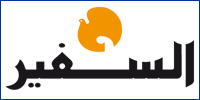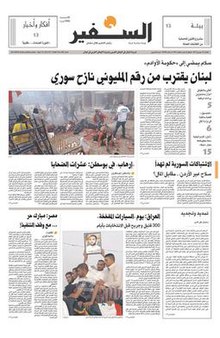As-Safir
 | |
 As-Safir front page, 16 April 2013 | |
| Type | Daily newspaper |
|---|---|
| Format | Broadsheet |
| Publisher | Dar Al Safir |
| Editor | Talal Salman |
| Founded | 26 March 1974 |
| Political alignment | Arab nationalism Pan-Arabism Anti-Zionism Anti-imperialism Pro-March 8 Alliance |
| Language | Arabic |
| Ceased publication | 31 December 2016 |
| Headquarters | Beirut, Lebanon |
| Website | www |
As-Safir (Arabic: السفير, lit. 'The Ambassador') was a leading Arabic-language daily newspaper in Lebanon. The headquarters of the daily was in Beirut.[1] It was in circulation from March 1974 until December 2016.[2] The last issue of the paper was published on 31 December 2016. The online version was also closed on the same date.[2]
Aimed at political coverage, As-Safir dubbed itself the "Voice of the Voiceless", serving as a key news source for Lebanese in the Arab world. It espoused Arab nationalism and supported the Palestinians, aligning with the March 8 Alliance. Its rival an-Nahar is associated with the March 14 alliance.[3]
History and profile
[edit]As-Safir was first published by Talal Salman on 26 March 1974 as an Arabic political daily.[4][5] Talal Salman also served as chief editor of the paper.[6] Bassem Sabeh was the chief editor of the paper between 1980 and 1990.[7] In 2005, the daily's chief editor was Joseph Samaha.[8][9] The publisher of the daily which was published in broadsheet format was Dar Al Safir.[1][10]
One of the early contributors was Palestinian cartoonist Naji Al Ali.[11] Another contributor was Samir Frangieh.[7]
On 18 July 2011, the paper, together with Al Akhbar, another daily published in Lebanon, was banned in Syria.[12]
As-Safir had a weekly page on the environmental issues.[13]
Political approach
[edit]As-Safir stated its mission as to be "the newspaper of Lebanon in the Arab world and the newspaper of the Arab world in Lebanon."[14] This remained the slogan printed on the paper's masthead.[5] It also adopted the slogan "The voice of voiceless". The paper provided an independent voice for the left-wing, Pan-Arab tendency which was increasingly active in Lebanese intellectual and political life in the years after the Arab defeat in the Six-Day War.[15] It also focused on issues pertaining to the Muslim world, advocated Arab nationalism, was close to Hezbollah and had a pro-Syrian stance.[16]
Another Lebanese daily, An-Nahar, was cited as the biggest rival of As-Safir.[17] In the mid-1990s, the paper was described as a left-of-center paper, whereas An-Nahar as a right-of-center paper.[18] During the same period, As-Safir was also described by Robert Fisk as a Syrian-backed newspaper.[19] In the 2000s these papers were supporters of two opposite poles in Lebanon, in that An-Nahar supported March 14 alliance, whereas As-Safir supported March 8 alliance.[20]
Circulation and websites
[edit]As-Safir had the second highest circulation in Lebanon in the 1990s after An-Nahar.[18] Its circulation was 45,000 copies in 2003, making it the second best selling paper in Lebanon.[10] The paper sold more than 50,000 copies in 2010.[21] In 2012, the Lebanese Ministry of Information reported that the daily had a circulation of 50,000 copies.[4][20][22] The circulation of the paper was less than 10,000 copies in 2016 when it folded.[21]
In addition to its Arabic website, the paper had also an English website.[23] The paper's online version was the 16th most visited website for 2010 in the MENA region.[24]
See also
[edit]References
[edit]- ^ a b "Media Landscape". Menassat. Archived from the original on 20 February 2019. Retrieved 22 September 2013.
- ^ a b "Lebanese newspaper As-Safir to stop publishing after 40 years". An Nahar. 9 December 2016. Retrieved 1 March 2020.
- ^ Najem, Tom; Amore, Roy C.; Abu Khalil, As'ad (2021). Historical Dictionary of Lebanon. Historical Dictionaries of Asia, Oceania, and the Middle East (2nd ed.). Lanham Boulder New York London: Rowman & Littlefield. p. 41. ISBN 978-1-5381-2043-9.
- ^ a b "Lebanon. Media Landscape". European Journalism Center. Archived from the original on 8 September 2014. Retrieved 15 September 2014.
- ^ a b "Lebanon" (PDF). Publicitas. Archived from the original (PDF) on 2 December 2012. Retrieved 8 June 2012.
- ^ Ranwa Yehia (27 January – 2 February 2000). "Salam bid farewell". Al Ahram Weekly. 466.
- ^ a b Who's Who in Lebanon (19th ed.). Beirut: Publitec Publications. 2007. pp. 132, 298. doi:10.1515/9783110945904.476. ISBN 978-3-598-07734-0.
- ^ Jad Mouawad (9 March 2005). "Lebanese Lawmakers Bring Back Pro-Syrian Prime Minister". The New York Times. Retrieved 18 March 2013.
- ^ Serene Assir (21–27 April 2005). "Divided we fall". Al Ahram Weekly. 739. Archived from the original on 25 March 2013. Retrieved 15 April 2013.
- ^ a b "World Press Trends" (PDF). Paris: World Association of Newspapers. 2004. Archived from the original (PDF) on 8 February 2015. Retrieved 15 February 2015.
- ^ Michael R. Fischbach (2005). "al-Ali, Naji". In Philip Mattar (ed.). Encyclopedia of the Palestinians. New York: Facts on File, Inc. p. 18. ISBN 978-0-8160-6986-6.
- ^ "Press and Cultural Freedom in Lebanon, Syria, Jordan and Palestine" (Annual report). SKeyes. 2011. Retrieved 10 October 2014.
- ^ Najib Saab. "The Environment in Arab Media" (PDF). Arab Forum for Environment and Development. Archived from the original (Report) on 10 October 2014. Retrieved 7 October 2014.
- ^ Dany Badran (2013). "Democracy and Rhetoric in the Arab World". The Journal of the Middle East and Africa. 4 (1): 65–86. doi:10.1080/21520844.2013.772685. S2CID 143657988.
- ^ Nick Cumming-Bruce (18 February 2013). "U.N. Rights Officials Urge Syria War Crimes Charges". The New York Times. Retrieved 26 April 2015.
- ^ "Mikati unveils 30-member Cabinet dominated by Hizbullah and March 8 allies". The Daily Middle East Reporter. 14 June 2011. Retrieved 10 March 2013.
- ^ Mohalhel Fakih (2–8 September 2004). "Pulling at Lebanon's strings". Al Ahram Weekly. 706. Archived from the original on 21 September 2013. Retrieved 19 April 2013.
- ^ a b Yahya R. Kamalipour; Hamid Mowlana (1994). Mass Media in the Middle East: A Comprehensive Handbook. Westport, CT: Greenwood Press. ISBN 978-0313285356.
- ^ Robert Fisk (13 May 1993). "Beirut newspaper defies closure: Lebanese officials say left-wing daily 'endangered security of the state' with peace talks report". The Independent. Beirut. Retrieved 31 July 2014.
- ^ a b "Mapping Digital Media: Lebanon" (PDF). Open Society Foundations. 15 March 2012. Retrieved 19 September 2013.
- ^ a b "The Lebanese Print Media Landscape". Media Ownership Monitor. Retrieved 6 May 2022.
- ^ "Lebanon Press". Press Reference. Retrieved 27 September 2013.
- ^ "English - جريدة السفير".
- ^ "Forbes Releases Top 50 MENA Online Newspapers; Lebanon Fails to Make Top 10". Jad Aoun. 28 October 2010. Archived from the original on 29 July 2016. Retrieved 11 September 2014.
External links
[edit]- Official website
 Media related to As-Safir at Wikimedia Commons
Media related to As-Safir at Wikimedia Commons
- 1974 establishments in Lebanon
- 2016 disestablishments in Lebanon
- Arab nationalism in Lebanon
- Arabic-language newspapers
- Defunct newspapers published in Lebanon
- Newspapers published in Beirut
- Pan-Arabist media
- Newspapers established in 1974
- Publications disestablished in 2016
- Daily newspapers published in Lebanon
